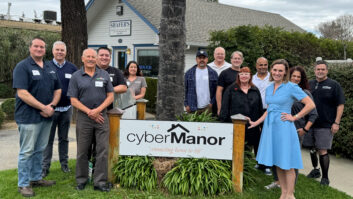Tech system consultants have been a part of our industry for years. Though they’re not new, substantial anecdotal evidence suggests that their surging influence–at least in major metro markets–is new. In the past, their impact had been limited to a small percentage of ultra high-end residential installations. This fact appears to be changing as several sources tell us that system consultants, or design consultants, are growing in both the number and the range of projects. What is driving this growth? And what does this trend mean for integrators?

Andrew Southern
We reached out to three technical consulting companies to learn more about their role in the industry and to discover what trends they see for the segment. We spoke at length with Bob Kranson, founder of Axiom Design, a 24-year-old consulting company based in Walnut Creek, CA; Josh Christian, Axiom’s business development manager based in a new Los Angeles office; David VanWert of VanWert Technology Design in West Hollywood, CA; and finally, Andrew Southern of Andrew Southern Consulting in New York, NY.
Not Only is Technology Changing, But Consumers Are Changing Too
Let’s first acknowledge that much in the technology industry is changing. Not only is this change reflected in new products and cutting-edge technologies, but in the needs and desires of technology consumers. In particular, much of this change is in the way that consumers interact with technology. Want to watch a favorite movie or binge watch your favorite TV series? Power up Netflix on your Roku. Need a taxi cab? Launch the Uber app on your smartphone and a car will be at your disposal within a matter of minutes.
Custom integration has largely been immune to these mega-trend changes other than to incorporate new consumer products into installations. But some now argue that this trend in consumer preference is beginning to change the custom integration industry in fundamental ways as well. Clients, they say, are interested in a new approach to learning about what options are available in tech, and in a new process for how this technology is acquired for their residential construction projects.
The Previous Integrator-Centric Model
For decades, the solution for almost all installations called for clients to engage their local AV custom integrator. The common narrative often went like this: a friend of a high net-worth individual visits his home and sees a killer home theater. “I’m building a new house,” he exclaims. “Where can I get a system like this?” With a name and a number, the prospect calls his local integrator and a meeting would be set up. The integrator would meet with the client to assess his needs, build a proposal to present his suggested solution, and upon acceptance of the proposal, order the products and schedule the installation.
In the early days of the industry, proposals would often be little more than a Microsoft Word document, an Excel spreadsheet of items included, and possibly a Visio block diagram showing a basic system design. Over time, more software tools become available to make proposals much more attractive and better organized.
The prospect relied on the integrator to help him determine what system would best meet his needs. But consumers, even high net-worth consumers, aren’t usually engineers or technologists. Often, they would seek out proposals from multiple integrators for the sake of comparison. But the result of this process was often the receipt of frustratingly different proposals–dramatically different in composition and price–making comparisons almost impossible.
One Common Thread
What’s normal to those of us in the industry is paradoxically puzzling to non-technical types, also known as our clients. Their requirements didn’t change; so why are the integrators’ proposals so radically different? There are, of course, many reasons why different integrators interpreted the client’s needs so differently–but smart clients noticed one common thread that ran through each of these proposals. Integrators write proposals that recommend the products that they sell.
The clients were most often lost by the end of the process. They didn’t have the technical expertise to determine which proposal offered the design that was the best match to their needs, and they had no idea if the pricing of any of these proposals was fair. There had to be a better way.
Tech Model Disconnected from Construction Model
When you think about it, the “normal” process is a little crazy. If you decide to build a house, at the very least you’ll typically hire an architect to design it, a general contractor to build it, and interior designer to decorate it. There may also be other inputs to the design team such as a lighting designer, a landscape designer, mechanical-electrical-plumbing engineering; but one thing all these people have in common is this: They are your design team, and they work for you. The design team is on your side, with the sole goal of helping sort through options to craft your vision, and then bring your vision to reality.
Once you and your team have completed a design you are happy with, then they will need to engage contractors from various trades involved to bid on the work of building and completing the home. Plumbing contractors, electrical contractors, and the like will all submit bids to bring the designs to life.
Yet typically, AV integrators have not participated on the design team, at least not in the initial design phase. As a result, integrators’ designs are “kind of done in a vacuum,” Axiom’s Christian said. This is largely because architects and interior designers view AV integrators as a contractor–not a designer.
No Small Distinction:–An Integrator is ‘Just a Contractor’
“One architect told me that clients don’t want to ‘marry’ the AV contractor too early in the process,” Christian said, relaying a story from his days as an integrator. “No matter how good [integrators] think their design is, they’re still just a contractor.”
This is no small distinction. Technical system consultants are brand agnostic: their compensation is dependent on designing a system that best translates and serves the needs of the client, and with which those clients are completely happy. But an integrator has much of his compensation dependent on selling products–not just any product, but the specific lines, representing a subset of the total technical world–for which they are authorized to sell.
“It’s like an inherent conflict of interest,” said Christian, who once worked for Via, a large integration company. “Integrators are not a neutral party in the design process; they have an agenda to sell their brands.” But the typical technical consultant, by contrast, “is in a consultative role. They gain more trust, [because they] pitch based on the client’s needs.”

David VanWert
David VanWert of VanWert Technical Design added, “In our systems we specify anything from Crestron to Savant to stand-alone apps, like Sonos and Nest. If you’re an integrator and you only represent Crestron, then you’re going to only tell the client about that solution. You might not let them know about other solutions that would be just as good of a fit–or even a better fit.”
“I think people appreciate an expert opinion on things, especially if it can potentially save them money or prevent them from making a mistake,” Andrew Southern of Andrew Southern Consulting said. “They’re looking for an unbiased opinion, and that an integrator can’t unfortunately provide, because they have a conflict that is built into the business model. They’re selling to the client so they’re on the opposite side of the line; whereas the consultant is on the same side of the line with the customer.”
There are three basic components to a whole-home technology system project: design/engineering, construction/installation, and programming. (Note that some consider programming to be part of the installation process.) “These are three different roles with three very different skill sets,” Axiom’s founder Bob Kranson said. “It is almost impossible for any one company to be ‘best-in-class’ in all three of them.”

Bob Kranson
In the commercial business, it is very common to have separate design firms and installation contractors, while in the residential business the more common solution is one integration firm handles all three processes. According to knowledgeable insiders, the vast majority of commercial projects–perhaps as many as 85 to 90 percent–employ a separate design consultant. For clients who are professional people, this feels normal to them. It only makes sense they would seek out the same type of consulting service for their home systems as well.
“Consultants on the commercial side are a dime-a-dozen,” joked VanWert.
The Consultant-Centric Model
The typical process for the client who utilizes the services of a technical or design consultant takes some of the same steps as the process conducted by a traditional AV integrator; but, because of the empirical objectivity of the consultant, from a whole new perspective. The technical consultant is typically brought into the project through a referral from an architect, general contractor, interior designer, or even by the homeowner, usually quite early in the process.
“In most cases we’re brought on very early in the construction cycle when construction documents are just finishing up–many times before a general contractor is even brought on board to the project,” VanWert said.
The consultant will then conduct an in-depth “needs analysis” by interviewing the client. Their role at this point is consultative, even educational, as clients generally have no idea what their range of options are with technology. Having someone explain it to them who does not have a vested interest in directly selling them the products being recommended adds a tremendous amount of credibility to the advice–and trust to the relationship.
Then, an initial high-level plan is developed with architectural designs showing device selection and approximate layouts. Along with this, an initial budget range is devised and presented to the client for approval. So far, to this point, the process is very similar between technical consultants and traditional AV integrators. But once the project is approved, the differences tend to become much more acute.
Using sophisticated computer-aided-design software, the technical consultant will build an extremely detailed, complete set of construction-grade plans. Since the consultant is part of the design team and brought into the process much earlier, there is detailed coordination between them and the other designers including the architect, interior designer, general contractor, and any other design professional involved.
Deeply Detailed
According to the interviewed consultants, design consultant’s plans tend to be much more detailed–with multiple views and elevations for each element of the system in each space of the project–than the more basic plans from a typical AV integration company. This added detail and forethought reduces the need for costly change orders in the field to accommodate unforeseen issues.
“Design, to me, has almost become a dirty word,” Kranson said. “When we started emphasizing the importance of design, ‘design’ wasn’t about telling someone what’s minimally necessary in order to get somebody to say ‘yes’ and buy; it had nothing to do with the buying process. Design was the process of being able to look at, evaluate, and educate a client as to what was possible, and then being able to share with them what would be involved in making that solution function within their specific application.”

Josh Christian
The finished consultant plans, often called the bid package, are then submitted to several AV integration companies to bid on the construction/installation portion of the job. And unlike the experience of clients in the AV-centric model, the responses are remarkably similar. With everyone bidding on the same system plan, “clients get a true apples-to-apples comparison,” Axiom’s Christian said.
“On one $750,000 project, we had four AV integrators bidding,” VanWert said. “The total variation was only $1,800 from the lowest bid to the highest bid. “That’s a remarkable two-tenths of one percent difference from multiple bidders. Clients can now make a more informed choice as to which contractor they’d prefer to work with, as the proposals are all now equalized.”
At this point in the process, the consultant’s role noticeably shifts from the client to the project–taking full responsibility to marshal the project to a successful conclusion. This includes construction site visits and interaction with any and all subcontractors.
“We now go from being the client advocate to the project advocate,” Kranson said. “Because it’s now our role to continue to assist the construction design team with any questions they have during the course of construction.”
What’s Driving Growth?
Contrary to the overall custom integration industry, all of the interviewed consulting firms told us that they have experienced tremendous growth over the last five years–good, profitable, employee-hiring, service-expanding growth. What’s driving this growth? All of those we spoke with mentioned that architects, interior designers, and general contractors were becoming much more aware of the availability of a technical consultant that is driving recommendations.
“Once clients and people in the design trade are educated that these services are available, in most cases the technical consultants are very welcome, because that’s the system that designers are used to,” VanWert said. “You know they’re used to a lighting designer; they’re used to an interior designer; they’re used to an electrical engineer; they’re used to a mechanical engineer, on every single one of their projects. Now that there’s this other giant missing piece that’s also able to be designed the same way, it makes a lot of sense.”
“I always thought it was silly that every other part [of the residential construction project] is designed by a design professional and then bid out competitively, and then the tradesmen come in and build it, except for AV. And for years, these other guys [AV integrators] would come in and did the selling and the installing,” said Andrew Southern. “I just wanted AV to be delivered the same way as the plumbing.”
Another factor driving demand for consultants is the increase in the number of projects coming from second-or third-time technology buyers. These homeowners have already experienced some level of an automation system in a previous home, usually purchased through an AV integrator.
“I would say maybe 40 percent of my customers have lived in an automated home of some sort previously,” Southern said. “And so they’re more familiar with the process, and for whatever reason they’ve sought out a consultant to help them this time around. So you’ve got to think that there’s something maybe not so comfortable about the original wild west model [working with an AV integrator] that we were all following for so long.”
Good News for Integrators
The good news for integrators is that the rise of the technical consultants’ influence has not come at their expense. While the consultant will take over the initial sales, design, and engineering component of the project, when it comes time to construct and install the system, they still go to an integrator. So, for only a few hours’ time invested to develop a quote during the bidding process, the winning integrator gets a pre-qualified and presold customer. What is that worth? Kranson said that over the years, Axiom has “generated over a quarter-of-a-billion dollars in work for the trades.”







